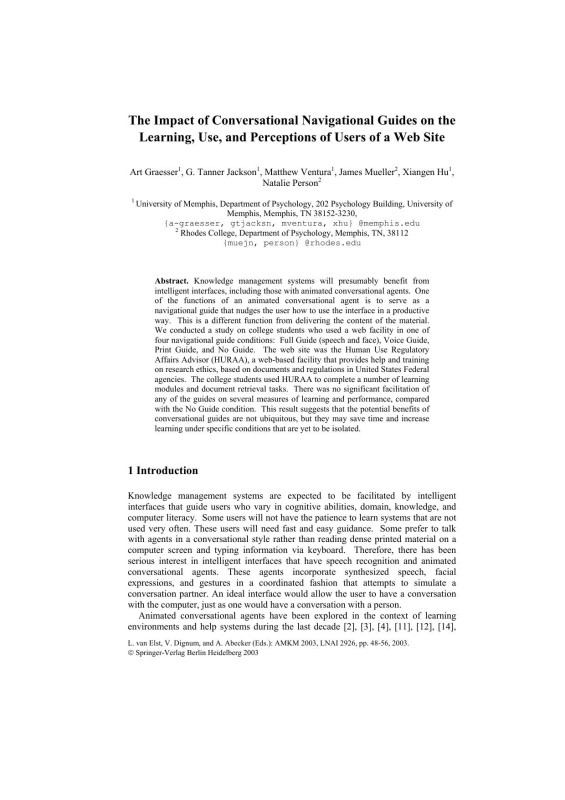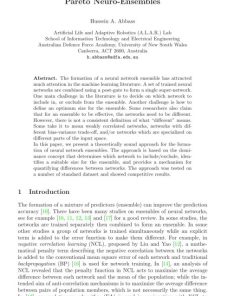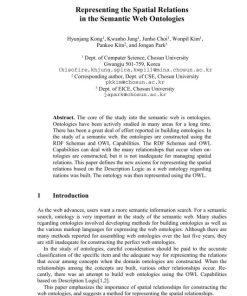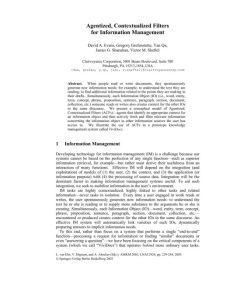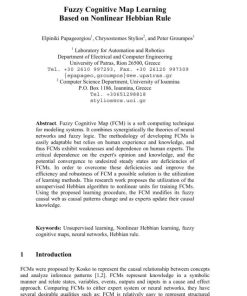LNAI 2926 The Impact of Conversational Navigational Guides on the Learning Use and Perceptions of Users of a Web Site 1st Edition by Art Graesser, Tanner Jackson, Matthew Ventura, James Mueller, Xiangen Hu, Natalie Person ISBN 9783540206460 354020646X
$50.00 Original price was: $50.00.$25.00Current price is: $25.00.
Authors:Art Graesser, G. Tanner Jackson, Matthew Ventura, James Mueller, Xiangen Hu; Natalie Person , Tags:Agent-Mediated Knowledge Management , Author sort:Art Graesser, G. Tanner Jackson, Matthew Ventura, James Mueller, Xiangen Hu & Person, Natalie , Languages:Languages:eng , Published:Published:Nov 2003
LNAI 2926 The Impact of Conversational Navigational Guides on the Learning Use and Perceptions of Users of a Web Site 1st Edition by Art Graesser, Tanner Jackson, Matthew Ventura, James Mueller, Xiangen Hu, Natalie Person – Ebook PDF Instant Download/Delivery. 9783540206460 ,354020646X
Full download LNAI 2926 The Impact of Conversational Navigational Guides on the Learning Use and Perceptions of Users of a Web Site 1st Edition after payment
Product details:
ISBN 10: 354020646X
ISBN 13: 9783540206460
Author: Art Graesser, Tanner Jackson, Matthew Ventura, James Mueller, Xiangen Hu, Natalie Person
Knowledge management systems will presumably benefit from intelligent interfaces, including those with animated conversational agents. One of the functions of an animated conversational agent is to serve as a navigational guide that nudges the user how to use the interface in a productive way. This is a different function from delivering the content of the material. We conducted a study on college students who used a web facility in one of four navigational guide conditions: Full Guide (speech and face), Voice Guide, Print Guide, and No Guide. The web site was the Human Use Regulatory Affairs Advisor (HURAA), a web-based facility that provides help and training on research ethics, based on documents and regulations in United States Federal agencies. The college students used HURAA to complete a number of learning modules and document retrieval tasks. There was no significant facilitation of any of the guides on several measures of learning and performance, compared with the No Guide condition. This result suggests that the potential benefits of conversational guides are not ubiquitous, but they may save time and increase learning under specific conditions that are yet to be isolated.
LNAI 2926 The Impact of Conversational Navigational Guides on the Learning Use and Perceptions of Users of a Web Site 1st Edition Table of contents:
Chapter 1: Introduction to Conversational Navigational Guides
- 1.1. What Are Conversational Navigational Guides?
- 1.2. The Role of Conversational Agents in Modern Web Design
- 1.3. The Relationship Between Navigation, Learning, and User Engagement
- 1.4. Research Objectives and Scope of the Study
- 1.5. Structure of the Book
Chapter 2: Theories and Frameworks for Understanding Conversational Guidance
- 2.1. Cognitive Load Theory and User Learning
- 2.2. Theories of Human-Computer Interaction (HCI)
- 2.3. The Role of Conversational Interfaces in Enhancing Learning
- 2.4. Social Presence Theory and Its Relevance to Web Navigation
- 2.5. Framework for Evaluating User Experience and Perceptions
Chapter 3: Conversational Interfaces: Design and Technology
- 3.1. Overview of Conversational Agent Technologies (Chatbots, Voice Assistants, etc.)
- 3.2. Key Design Principles for Effective Conversational Interfaces
- 3.3. Natural Language Processing (NLP) and Its Role in Web Navigation
- 3.4. Customizing Conversational Guides for Specific User Needs
- 3.5. Case Studies: Designing Conversational Navigational Guides for Different Web Domains
Chapter 4: The Role of Conversational Guides in User Learning
- 4.1. Cognitive Mechanisms in Web-Based Learning
- 4.2. Enhancing User Understanding with Conversational Agents
- 4.3. Interactive Learning through Guided Conversations
- 4.4. Personalization of Learning Content via Conversational Agents
- 4.5. Case Study: Conversational Guidance in Online Education Platforms
Chapter 5: User Perceptions of Conversational Navigational Guides
- 5.1. Defining User Perceptions in Web Navigation
- 5.2. Factors Influencing User Perceptions: Efficiency, Ease of Use, and Trust
- 5.3. The Emotional Impact of Conversational Agents on Users
- 5.4. Measuring User Satisfaction with Conversational Navigational Guides
- 5.5. Case Study: Perceptions of Conversational Guides in E-Commerce Websites
Chapter 6: Experimental Methodology: Studying the Impact of Conversational Guides
- 6.1. Research Design: Experimental Setup and Variables
- 6.2. Participant Selection and Demographics
- 6.3. Data Collection Methods: Surveys, Interviews, and Usage Data
- 6.4. Metrics for Evaluating User Learning, Use, and Perceptions
- 6.5. Analyzing Results: Statistical Techniques and Qualitative Insights
Chapter 7: Impact of Conversational Guides on User Engagement and Website Use
- 7.1. How Conversational Interfaces Affect User Behavior and Engagement
- 7.2. Conversational Guidance and User Retention Rates
- 7.3. Influencing Decision-Making and Task Completion with Conversational Agents
- 7.4. Conversational Agents and User Journey Mapping
- 7.5. Case Study: Conversational Guides in Health Websites for Patient Education
Chapter 8: Comparative Analysis: Conversational Navigational Guides vs. Traditional Navigation Systems
- 8.1. Advantages and Disadvantages of Conversational vs. Static Navigation
- 8.2. User Preferences: Conversational Interfaces vs. Menu-Based Systems
- 8.3. Effectiveness of Conversational Agents in Different Types of Websites
- 8.4. Case Study: Comparing User Experience in Conversational vs. Traditional E-Learning Platforms
- 8.5. Summary of Key Findings from Comparative Analysis
Chapter 9: Ethical Considerations and Best Practices in Designing Conversational Guides
- 9.1. Ethical Issues in Designing Conversational Agents: Transparency, Privacy, and Trust
- 9.2. Avoiding Bias in Conversational Design and User Interaction
- 9.3. Ensuring Accessibility for All Users
- 9.4. User Consent and Data Privacy Considerations
- 9.5. Guidelines for Designing Ethical and Effective Conversational Agents
Chapter 10: Future Directions in Conversational Navigational Guides
- 10.1. Emerging Trends in Conversational Interface Technology
- 10.2. The Role of AI and Machine Learning in Improving Conversational Navigation
- 10.3. Integrating Conversational Agents with Augmented and Virtual Reality
- 10.4. Future Research Directions in User Learning and Interaction with Web Guides
- 10.5. The Future of Conversational Agents in Personalized Web Experiences
Chapter 11: Conclusion
- 11.1. Summary of Findings and Contributions of the Book
- 11.2. The Impact of Conversational Navigational Guides on User Learning and Perceptions
- 11.3. Final Thoughts on Designing User-Centered Conversational Interfaces
People also search for LNAI 2926 The Impact of Conversational Navigational Guides on the Learning Use and Perceptions of Users of a Web Site 1st Edition:
importance of conversation in relationship
importance of conversations
navigational conversations
what is the impact of conversational language
You may also like…
eBook PDF
LNAI 2903 Pareto Neuro Ensembles 1st Edition by Hussein Abbass ISBN 9783540206460 354020646X

